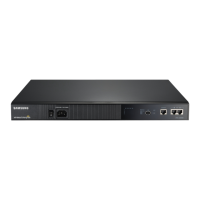
Do you have a question about the Samsung IPX-S300B and is the answer not in the manual?
Describes the ACD server's role in distributing incoming calls to agents and collecting statistics.
Details the voice mail service and its features for user messages and notifications.
Sets maximum call limits based on counts, bandwidth, system resources, or trunk calls.
Encrypts signaling information for VoIP calls using protocols like SIP and TLS.
Encrypts voice data exchanged between callers using secure RTP (sRTP).
Describes the internal authentication process between SIP phones and the IPX-S300B.
Allows users to enter account codes for external calls through trunks for charge calculation.
Automatically records calls whenever they are started, with options for call type selection.
Explains the need to create and assign application server service groups for server interface support.
Allows assigning agent IDs and enabling agents to answer calls using their ID and password.
Configures call distribution among agents and standby announcement methods.
Describes agent statuses: Logged in, Wrap-up, and Break.
Lists conference features like Add-On Conference, Conference On Answer (COA), Predefined, Intercom, Dispatch, and Meet-Me conferences.
Allows the master to view status, mute/eject members, lock, and terminate the conference.
Provides voice mail service when callers are unavailable, allowing message access from anywhere.
Details specifications for call recording, including VPU number, channel limits, and recording time.
Unified Communications Client software for PC integration with telephones, supporting Voice and Video.
Allows agents to make calls, answer, transfer, and conference calls via the computer.
Provides real-time status of the ACD Group, including wait calls and logged-in agents.
Details interfacing with servers using standard SIP protocols like conference and VMS servers.
Details interfacing with external applications using standard CSTA Phase-II protocol.
Uses standard SIP protocol for interfacing with servers like conference and VMS.
Uses standard CSTA Phase-II protocols for interfacing with ACD and IP relay servers.
Manages SIP signaling and media transfer between inside and outside, supporting UDP, TCP, and TLS.
Adjusts routing based on source address in SIP messages and subscriber registration.
Rejects SIP signaling from unauthorized IP addresses and hides topology for SIP messages.
Allows use of alternative routes in case of SIP entity validation issues or problems.
Controls operator access and manages operator IDs, passwords, levels, and timeouts.
Manages system processes by starting, stopping, monitoring, and retrieving version information.
Monitors process status, automatically restarts failed processes, and handles abnormal terminations.
Describes possible process statuses: NORMAL, ALIVE, WAIT, or FAIL.
Categorizes processes into Critical, Major, and Normal levels based on system impact.
Allows operators to stop running or start stopped processes via the Performance menu.
Provides information on process version, creation date, and creation time.
Allows viewing or changing system configuration through the SCM Administrator's configuration menu.
Monitors system resources in intervals, displaying information and generating alarms for problems.
Displays CPU, memory, and hard disk usage charts and viewer information.
Generates alarms for specific process CPU usage increases, notifying administrators of system problems.
Manages extension users by adding, deleting, or changing them in the database.
Manages trunk users by adding, deleting, or changing them in the database.
Provides statistical call information by hours, dates, and months, covering system, user, service, and route statistics.
Defines the parameters and descriptions for call log entries, covering header, number, and usage details.